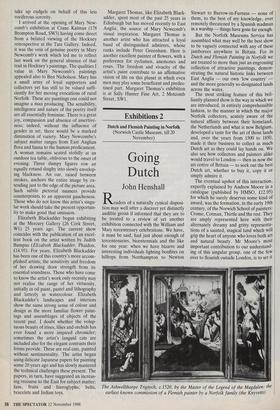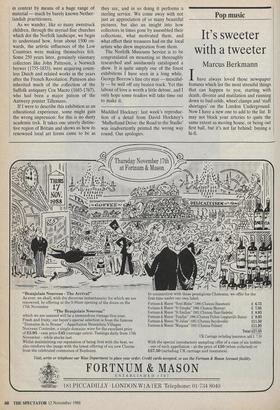Exhibitions 2
Dutch and Flemish Painting in Norfolk (Norwich Castle Museum, till 20 November)
Going Dutch
John Henshall
Readers of a naturally cynical disposi- tion may well utter a discreet yet distinctly audible groan if informed that they are to be treated to a review of yet another exhibition connected with the William and Mary tercentenary celebrations. We have, it must be said, had just about enough of tercentenaries, bicentennials and the like for one year: when we have bizarre and interesting individuals lighting bonfires on hilltops from Northampton to Newton Stewart to Barrow-in-Furness — none of them, to the best of my knowledge, ever remotely threatened by a Spanish madman in a warship — things have gone far enough.
But the Norfolk Museums Service has assembled what may well be the best show to be vaguely connected with any of these jamborees anywhere in Britain. For in Dutch and Flemish Painting in Norfolk we are treated to more than just an engrossing collection of attractive paintings, demon- strating the natural historic links between East Anglia — our own 'low country' — and the more generally so-designated lands across the water.
The most striking feature of this bril- liantly planned show is the way in which we are introduced, in entirely comprehensible fashion, to the manner in which the major Norfolk collectors, acutely aware of the natural affinity between their homeland, the Netherlands and what is now Belgium, developed a taste for the art of those lands and, over the years from 1500 to 1850, made it their business to collect as much Dutch art as they could lay hands on. We also see how collectors and painters alike would travel to London — then as now the art centre of Britain — to seek out the best Dutch art, whether to buy it, copy it or simply admire it.
The eventual upshot of this interaction, expertly explained by Andrew Moore in a catalogue (published by HMSO, £12.95) for which he surely deserves some kind of award, was the formation, in the early 19th century, of the Norwich School of painters: Crome, Cotman, Thirtle and the rest. They are amply represented here with their alternately dreamy and gritty representa- tions of a sainted, magical land which will grip the heart of anyone who loves both art and natural beauty. Mr Moore's most important contribution to our understand- ing of this singular group, one of the few ever to flourish outside London, is to set it The Ashwellthorpe Triptych, c.1520, by the Master of the Legend of the Magdalen: the earliest known commission of a Flemish painter by a Norfolk family (the Knyvetts) in context bir means of a huge range of material — much by barely known Nether- landish practitioners.
As we wander, like so many awestruck children, through the myriad fine churches which dot the Norfolk landscape, we begin to understand how, from about 1500 on- wards, the artistic influences of the Low Countries were making themselves felt. Some 250 years later, genuinely visionary collectors like John Patteson, a Norwich brewer (1755-1833), were acquiring count- less Dutch and related works in the years after the French Revolution. Patteson also inherited much of the collection of the Suffolk antiquary Cox Macro (1683-1767), who had been a major patron of the Antwerp painter Tillemans.
If I were to describe this exhibition as an educational experience, some might gain the wrong impression: for this is no dusty academic trek. It takes one utterly distinc- tive region of Britain and shows us how its renowned local art forms came to be as they are, and in so doing it performs a sterling service. We come away with not just an appreciation of so many beautiful pictures, but also an insight into how collectors in times gone by assembled their collections, what motivated them, and what effect their treasures had on the local artists who drew inspiration from them.
The Norfolk Museums Service is to be congratulated on mounting so thoroughly researched and assiduously catalogued a show. It is quite simply one of the finest exhibitions I have seen in a long while. George Borrow's fine city may — merciful- ly — be well off any beaten track. Yet this labour of love is worth a little detour, and I only hope some readers will take time out to make it.











































































 Previous page
Previous page